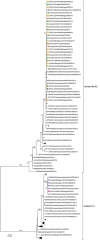Influenza A(H3N2) Virus in Swine at Agricultural Fairs and Transmission to Humans, Michigan and Ohio, USA, 2016
- PMID: 28820376
- PMCID: PMC5572863
- DOI: 10.3201/eid2309.170847
Influenza A(H3N2) Virus in Swine at Agricultural Fairs and Transmission to Humans, Michigan and Ohio, USA, 2016
Abstract
In 2016, a total of 18 human infections with influenza A(H3N2) virus occurred after exposure to influenza-infected swine at 7 agricultural fairs. Sixteen of these cases were the result of infection by a reassorted virus with increasing prevalence among US swine containing a hemagglutinin gene from 2010-11 human seasonal H3N2 strains.
Keywords: Michigan; Ohio; RNA viruses; United States; agricultural fair; animal population groups; animals; disease outbreaks; influenza A virus; livestock; public health; respiratory infections; swine; zoonoses.
Figures


References
-
- Schicker RS, Rossow J, Eckel S, Fisher N, Bidol S, Tatham L, et al. Outbreak of influenza A(H3N2) Variant virus infections among persons attending agricultural fairs housing infected swine—Michigan and Ohio, July–August 2016. MMWR Morb Mortal Wkly Rep. 2016;65:1157–60. 10.15585/mmwr.mm6542a1 - DOI - PubMed
MeSH terms
Grants and funding
LinkOut - more resources
Full Text Sources
Other Literature Sources
Medical

